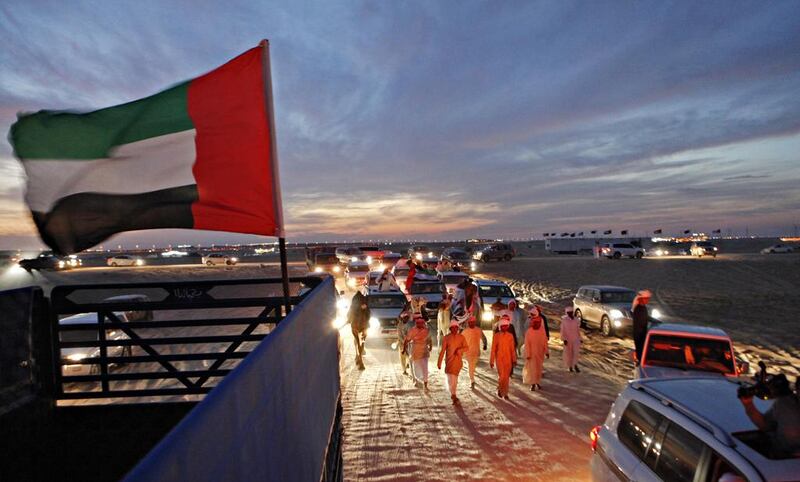Just as Emirati pilgrims rejected concerns about the Middle East Respiratory Syndrome during Haj, camel race organisers have no plans to cancel large scale sporting events next season. After the pause for summer, owners expect business as usual when September comes.
Yesterday I discussed the personal relationship between owners and camels. More significant is the social and political unity indirectly created by the camel. This is a direct result of the modern state and technology.
While the direct relationship between man and camel has dwindled - camel care is almost entirely outsourced to men from migrant countries - the camel remains essential in building the relationship between people, between states and between people and the state.
Much has been made of the role of sport in fostering national identities, centred around the state or region - in this case Emirati, Gulf or Arab.
This takes place ostentatiously at cultural festivals celebrating heritage but also on a deeper level within the private sphere at ezba hobby farms where men meet on weekends and after work.
First of all, camel races physically unite people from and in different emirates, something that is not often done.
While it is common for men in the northern emirates to travel to Dubai or Abu Dhabi for work, it is less typical for people from large cities to visit northern emirates like Ras Al Khaimah, Umm Al Quwain and Ajman.
The northern emirates can still feel a world removed from Dubai and Abu Dhabi in culture, daily life and physical infrastructure.
Much has been done since 2011 to address disparities in infrastructure and housing. State sponsored races address differences on an emotional level.
The track is one of the few places with widespread socialising between Emiratis from different emirates in the northern emirates. During race season this occurs at a different emirate each week.
Secondly, people are further united through shared experiences, interests and symbols. National myths are built through history, poetry, folk songs and language that can differ greatly with urban dialects.
Camels are decorated with national flags, tents are hung with framed photos of rulers. The nation is revisited and reinforced, constructed and defined.
The emphasis on the state is fitting. Although people claim to race for tradition, camel racing as a formal sport did not exist prior to the formation of the modern state and could only emerge with modern technology.
In the days before live television, nobody would buy camels from other emirates if they could not attend the races. There was trust, but unless the camel was truly renowned, then high purchases common today were too great an investment based on word of the camel’s performance. These days, social media strengthens participation with men from eastern Oman up through Kuwait.
Races are often sponsored by sheikhs, who build solidarity through public meetings and redistribute millions of dollars every season through prizes. Sheikhs may also share wealth through the purchase of camels or give valuable camels away.
Of prime importance is the chance for leaders to connect. Sheikhs and wealthy businessmen host lavish meals at camel events for the public. These are important opportunities for rulers to hear issues from a cross-section of citizens, a crucial aspect of the country’s political system. Additionally, sheikhs forge relationships with non-nationals alongside the track, giving free food and drink to workers at major festivals.
If small Friday races unite state populations, beauty contests like Al Dhafra unite the region. When I attended the two-week Al Dhafra festival in 2012, the Saudi family I stayed with spent little more than an hour a day with their camel Kaydah, who had been chosen to represent the Dawasir tribe. Receiving guests, however, was a full time job.
Some were close family who travelled across the peninsula, but often they were strangers. When strangers appeared, and they often did, conversations always began by establishing relationships, however distant, through family and tribal ties, shared history and experiences. Our camp’s dallah coffee pot and smouldering coals served a very real function.
The financial success promised by camel sports makes it possible to keep large herds that would be otherwise impractical, financially and ecologically. This encourages migration between Western Abu Dhabi and Saudi Arabia for grazing, and encourages owners to travel to Oman or Sudan for purchasing, further strengthening transnational ties.
These ties are not exclusively limited to the Gulf, although the roles of owner, trader, handler are clearly delineated by nationality, if only informally.
There is a strong reason that the public and the government want events that strength national and regional relations to continue.
The idea of keeping distance from camels is not just a matter of staying away from a pet. It’s giving up an occupation that fosters political ties and stability.





